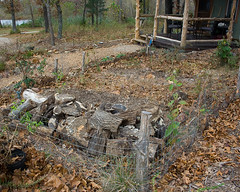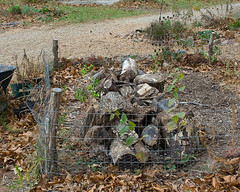Getting stuff done: Hugelkultur beds and greenhouse bed
 With questions about my residency I'd put a few projects on hold but now that it's all cleared up I've gotten back to work.
With questions about my residency I'd put a few projects on hold but now that it's all cleared up I've gotten back to work.
I doubt it is possible to mouse-proof a greenhouse but I did my best. Last year they ate up my greens, this year hopefully it won't be so easy for them. I put some semi-composted chicken bedding into the soil and got some kale, lettuce, spinach and chard planted. We'll see what happens. I've also stapled up the remaining bubble wrap on the inside ceiling for an added layer of insulation. Last, I've got the north side wall that is shared with the chicken coop stacked up with an internal straw bale wall. I'll also put bales on the east side. I noticed last year that while the water filled black barrels never froze up they also never gained any noticeable heat. Yeah, they were thermal mass but not warm. What I did notice though was that the straw bales that were in there warmed up really well. I figure it can't hurt and will likely help a great deal. I'll share data as the winter progresses. I'll keep one barrel inside filled for watering the plants.
 Next on the list, start the Hugelkultur beds in the little keyhole beds outside my cabin. For those that don't know, Hugelkultur is a form of raised garden bed using wood. This is especially important for me because the soil in this garden is contaminated with lead. Years ago this area was heavily mined and in fact the whole area is called the lead belt. The history of these towns is all based on the mining. Years later folk that probably shoud have known better but apparently didn't started using the tailings piles for roads, driveways and anywhere gravel, rock, or sand might be used. They used it around the lake on the roads and back in the 1970s and 80s they used it all around this place for the camp sites. Not smart. I could have them come in and take out the soil but frankly it is a huge mess and I don't necessarily trust the "soil" they bring in to replace the bad stuff. There's certainly nothing fertile about it as it is the brightest red clay you'll ever see. So, my intent is to build keep these beds raised high above the ground level, contaminated soil. I'll just rebuild them every couple of years until I've gotten several feet up.
Next on the list, start the Hugelkultur beds in the little keyhole beds outside my cabin. For those that don't know, Hugelkultur is a form of raised garden bed using wood. This is especially important for me because the soil in this garden is contaminated with lead. Years ago this area was heavily mined and in fact the whole area is called the lead belt. The history of these towns is all based on the mining. Years later folk that probably shoud have known better but apparently didn't started using the tailings piles for roads, driveways and anywhere gravel, rock, or sand might be used. They used it around the lake on the roads and back in the 1970s and 80s they used it all around this place for the camp sites. Not smart. I could have them come in and take out the soil but frankly it is a huge mess and I don't necessarily trust the "soil" they bring in to replace the bad stuff. There's certainly nothing fertile about it as it is the brightest red clay you'll ever see. So, my intent is to build keep these beds raised high above the ground level, contaminated soil. I'll just rebuild them every couple of years until I've gotten several feet up.
Hugelkulter is not hard to explain but I found this excellent post that does the job well:
Hugelkultur: Using Woody Waste in Composting:
Hugelkultur is an ancient form of sheet composting developed in Eastern Europe. It uses woody wastes such as fallen logs and pruned branches in order to build soil fertility and improve drainage and moisture retention.
If you walk through a natural woodland, you will see many fallen logs and branches on the ground. The older these logs are, the more life they sustain. A log that has rested on the forest floor for five or ten years will be covered in moss, mushrooms, wildflowers and even young trees. Poke at it a little and you will notice that the decaying wood is damp in all but the most vicious of droughts.
Hugelkultur is designed to take advantage of the natural fertility and moisture-conserving qualities of rotting wood, while speeding the process of decomposition up. The heat produced by decomposition also helps protect cold-sensitive plants.
In the photos above you can see I've got the semi-rotted wood hauled in and ready to be covered with straw, chicken manure, the last several scoops of wood chips we have. That wood is stacked up about 20 inches. I've got some good soil from our old wood pile (where this wood came from) and will just wheel barrel it down and add for the top layer. It's great stuff full of the rotted bark of lots of logs and is not contaminated. The final beds should be 24 inches above ground level. I'll post photos of the beds when they are completed. These will absorb water all winter and in early spring will be like water filled sponges. The decaying wood will rob the soil of nitrogen so I'll have to fertilize these beds heavily with chicken manure but I think it will be good and is certainly better than digging and growing in contaminated soil.